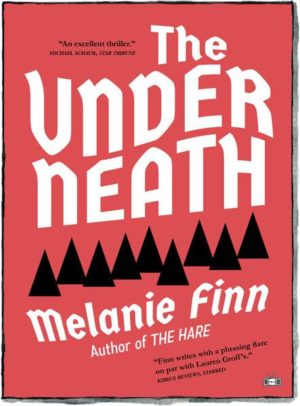You have no items in your cart. Want to get some nice things?
Go shopping
Some stories suck you in, while others lure you in, slowly, like the aroma of coffee on a cold day. Some stories might show you what’s at stake – the child’s life, the woman’s freedom, the man’s sanity – while others encourage you to find out for yourself, to read between the lines and see what’s there. In The Underneath, Melanie Finn has written one of those other stories, taking the reader downstream with gentle ripples rather than brutal waves. What first appears to be a quiet, relatively sanitised narrative gradually grows darker and dirtier, as the reader uncovers more of what is underneath the facades of marriage, motherhood, and rural America.
The novel opens in a Uganda rocked with civil strife. General Christmas and his soldiers are terrorising villages for the hell of it: “He had no insight, he had no grand plan, no sense of justice. He was just another asshole with a big gun.” In the midst of this terror is Kay Norton, a journalist who is tracking General Christmas’ actions but is no longer sure why: “Whatever we printed simply fed his hunger for publicity.” Accompanying Kay is Marco Morales, a photographer with a knack for winning over soldiers who “teeter between boredom and fear.” Little does Kay know that, years later, her life will teeter between those same states.
The chapters that follow alternate between these italicised entries documenting Kay’s African escapades and her life 10 years later. Now, she is married to a man, Michael, who will soon separate from her, and she has two children, Freya and Tom. They have all just moved into a rented house for the summer – an old country place in poor man’s Vermont. A far cry from Africa. Or is it? This older Kay, at first, reads like a different person. She is less active, more passive. But her passivity is like a light shining in the reader’s eye. The first of these 10 years later chapters opens with: “Kay felt the weight of the hammer in her hand.” She imagines lifting the hammer into the air, above the back of her husband’s head, and the “tow of gravity” willing it to come down. Only when her husband steps forward, “out of reach,” does Kay let the hammer drop to her side. They are inspecting the basement, a novelty for Kay and Michael, who have been living in London for years. If Kay did have a basement, she thinks, “it would contain…what we don’t really want anymore but can’t quite throw away.” The first visualisation of an “underneath,” the basement is a place of “danger unseen,” with rotting fifties wiring “tangled and twisted behind the walls.” It might also be the tomb of a cat, its front leg caught in a trap, already “sheering off, exposed bone and flesh.” Kay and Michael ponder what should be done with the cat, and eventually decide to take it to a vet, who tells them that it’s “a grand for amputation, 200 bucks” for euthanasia. “Kill it,” Kay says.
So begins The Underneath’s meditation on violence, humming in the background of Kay’s new domestic arrangement. She finds out that a hardened local, Ammon, is setting traps in the surrounding woodland to catch and kill coyotes. When Ammon refuses to stop laying the traps until after Kay and her children have left, she decides to reach out to her landlords, Frank and Maria. But it soon feels like Frank and Maria have vanished off the face of the earth, and then Kay finds a message, scratched into a wall in the house: “DIRTY SQUEAL SQUEAL DIRTY PIG SLIT YOU OPEN.” A mystery – and for Kay, the former globetrotting journalist who is now confined to a bleak corner of Vermont, an opportunity. She begins to investigate just as new faces enter her small world: Ben, and the two people he might or might not be trying to save – drug addict Shevaunne, and her young son, Jake. Soon, Kay is confronting a new kind of darkness that is also eerily familiar. So used to African poverty, she had “almost forgotten people could be poor in America. The lushness of the Vermont landscape obscured such despair, made it almost photogenic – rustic.” Here we discover another underneath, the flip side of a superpower, so unlike the deprived African settings that Kay was sent to report on, and yet also so similar.
The book succeeds in weaving a single thread of quiet terror through these alternating settings and, in the process, raises questions about the universality of violence. However, the great irony at the heart of the book is that Kay failed to notice this violence until now. She has seen “the slums and the war zones and the refugee camps,” but “we were journalists, we never stayed too long.” Kay had been jumping from place to place, seeing without ever really feeling, chasing that elusive Pulitzer Prize. It is only when she stops being a journalist and falls into the role of mother that she finally beings to notice the scent of darkness, its texture and boundaries. And little gestures are not enough to correct it. With her mind on the Syrian refugees and the children of South Sudan, she realises: “It was an absurd idea that if her own children ate their food it made anything better for those ravaged people.” She decides to eat the food herself, “so obscene the sight of wasted food in the garbage.” But this only conceals the problem, takes it to the realm of the underneath. It cannot address it.
In trying to address it, Kay is presented with a conundrum: Motherhood has given her a new space in which pressing problems are made known to her, but it also denies her the only means of fixing them that she knows. She isn’t a journalist anymore. “For 15 years, she’d been…writing, documenting, reporting. All those words, all those miles. She wrote about one war, and when it stopped or the editors lost interest, she waited for another. She’d felt so necessary, the work so imperative.” Whereas now, she is faced with the comparatively mundane need to relearn how to shop, how to cook, how to engage with a world in which, seemingly, nothing happens. The mystery at the novel’s heart is, in some ways, the result of Kay wanting something to happen, a problem that can be solved just as her professional and personal life feel beyond repair. But does this mean that Kay is a reluctant mother? She appears more like a conflicted one. In a scene half way into the book, she briefly loses her children when they go swimming in a lake. Upon finding them, she swings between love and rage. Watching the back of her daughter’s head, she wants to kiss it, and smack it. Then: “She thought about herself in the basement with the hammer.” A memory, the echo of violence seeping through.
After a slow first half in which more is said than done, the book picks up pace. Kay’s relationship with her children deteriorates, the harsh realities of working life in rural Vermont are brought into focus as Ben’s secrets come to light, and the different narratives start to coalesce. During this process, the underneath is brought to the surface. Is the act of raising children in the supposedly prosperous United States really so far removed from war? War comes in many forms. As Kay discovers, individuals are fighting for their livelihoods, their slice of the American Dream, and the line between good and evil is a blurred one. When the younger Kay is invited to interview General Christmas, she asks him about evil – “When did it begin for you?” The General is surprised that Kay thinks it’s a feeling, “like happiness or coldness.” If so, then hasn’t Kay ever felt it? No, she says, because she isn’t a killer. Killing is easy, Christmas replies. “We are designed to kill. Killing is our history, our design. It is our hands, our brains.” One can’t help but recall the older Kay, at the start of the book, with the hammer in her hand. But one is also confronted with another Kay, who worries feverishly about her children, who ponders living the small town life writing for a small town newspaper, who pleads “let me love.” Because, ultimately, the underneath is not something “other” that can be cut off from the performance of life. It is a part of life, informs life, in some cases even directs it. The Underneath brings up what is below not to banish it in a moment of triumph, but to observe it, address it, and, in some cases, accept it.
The Underneath
By Melanie Finn
Two Dollar Radio, 308 pages
About Robert Montero
Robert Montero is a London-based writer whose work has appeared in South Bank Poetry and London Grip, among others. A novel he wrote was long-listed for the Exeter Novel Prize.




